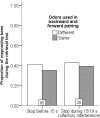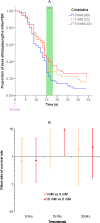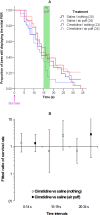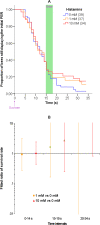Olfactory interference during inhibitory backward pairing in honey bees
- PMID: 18946512
- PMCID: PMC2568944
- DOI: 10.1371/journal.pone.0003513
Olfactory interference during inhibitory backward pairing in honey bees
Abstract
Background: Restrained worker honey bees are a valuable model for studying the behavioral and neural bases of olfactory plasticity. The proboscis extension response (PER; the proboscis is the mouthpart of honey bees) is released in response to sucrose stimulation. If sucrose stimulation is preceded one or a few times by an odor (forward pairing), the bee will form a memory for this association, and subsequent presentations of the odor alone are sufficient to elicit the PER. However, backward pairing between the two stimuli (sucrose, then odor) has not been studied to any great extent in bees, although the vertebrate literature indicates that it elicits a form of inhibitory plasticity.
Methodology/principal findings: If hungry bees are fed with sucrose, they will release a long lasting PER; however, this PER can be interrupted if an odor is presented 15 seconds (but not 7 or 30 seconds) after the sucrose (backward pairing). We refer to this previously unreported process as olfactory interference. Bees receiving this 15 second backward pairing show reduced performance after a subsequent single forward pairing (excitatory conditioning) trial. Analysis of the results supported a relationship between olfactory interference and a form of backward pairing-induced inhibitory learning/memory. Injecting the drug cimetidine into the deutocerebrum impaired olfactory interference.
Conclusions/significance: Olfactory interference depends on the associative link between odor and PER, rather than between odor and sucrose. Furthermore, pairing an odor with sucrose can lead either to association of this odor to PER or to the inhibition of PER by this odor. Olfactory interference may provide insight into processes that gate how excitatory and inhibitory memories for odor-PER associations are formed.
Conflict of interest statement
Figures









Similar articles
-
Forward and backward second-order Pavlovian conditioning in honeybees.Learn Mem. 2007 Oct 1;14(10):678-83. doi: 10.1101/lm.471307. Print 2007 Oct. Learn Mem. 2007. PMID: 17911371 Free PMC article.
-
Olfactory memory formation and the influence of reward pathway during appetitive learning by honey bees.J Exp Biol. 2007 Nov;210(Pt 22):4024-33. doi: 10.1242/jeb.006585. J Exp Biol. 2007. PMID: 17981870
-
Visual associative learning in restrained honey bees with intact antennae.PLoS One. 2012;7(6):e37666. doi: 10.1371/journal.pone.0037666. Epub 2012 Jun 6. PLoS One. 2012. PMID: 22701575 Free PMC article.
-
Nutritional value and taste play different roles in learning and memory in the honey bee (Apis mellifera).J Insect Physiol. 2018 May-Jun;107:250-256. doi: 10.1016/j.jinsphys.2018.04.014. Epub 2018 May 2. J Insect Physiol. 2018. PMID: 29729260
-
Revisiting olfactory classical conditioning of the proboscis extension response in honey bees: a step toward standardized procedures.J Neurosci Methods. 2012 Oct 15;211(1):159-67. doi: 10.1016/j.jneumeth.2012.08.018. Epub 2012 Aug 31. J Neurosci Methods. 2012. PMID: 22960052
Cited by
-
Responsiveness to Sugar Solutions in the Moth Agrotis ipsilon: Parameters Affecting Proboscis Extension.Front Physiol. 2019 Nov 26;10:1423. doi: 10.3389/fphys.2019.01423. eCollection 2019. Front Physiol. 2019. PMID: 31849694 Free PMC article.
-
Thymol Affects Congruency Between Olfactory and Gustatory Stimuli in Bees.Sci Rep. 2019 May 23;9(1):7752. doi: 10.1038/s41598-019-43614-8. Sci Rep. 2019. PMID: 31123276 Free PMC article.
-
Drosophila rely on learning while foraging under semi-natural conditions.Ecol Evol. 2013 Oct;3(12):4139-48. doi: 10.1002/ece3.783. Epub 2013 Sep 23. Ecol Evol. 2013. PMID: 24324865 Free PMC article.
-
The proboscis extension reflex to evaluate learning and memory in honeybees (Apis mellifera): some caveats.Naturwissenschaften. 2012 Sep;99(9):677-86. doi: 10.1007/s00114-012-0955-8. Epub 2012 Aug 7. Naturwissenschaften. 2012. PMID: 22869163 Review.
-
Molecular mechanisms underlying formation of long-term reward memories and extinction memories in the honeybee (Apis mellifera).Learn Mem. 2014 Sep 15;21(10):534-42. doi: 10.1101/lm.033118.113. Print 2014 Oct. Learn Mem. 2014. PMID: 25225299 Free PMC article. Review.
References
-
- Menzel R, Giurfa M. Dimensions of cognition in an insect, the honeybee. Behav Cogn Neurosci Rev. 2006;5:24–40. - PubMed
-
- Menzel R, Leboulle G, Eisenhardt D. Small Brains, Bright Minds. Cell. 2006;124:237–239. - PubMed
-
- Menzel R, Giurfa M. Cognitive architecture of a mini-brain: the honeybee. Trends Cogn Sci. 2001;5:62–71. - PubMed
-
- Milner B, Squire LR, Kandel ER. Cognitive neuroscience and the study of memory. Neuron. 1998;20:445–468. - PubMed
-
- Krasne FB, Glanzman DL. What We can Learn from Invertebrate Learning. Annual Review of Psychology. 1995;46:585–624.
Publication types
MeSH terms
Substances
Grants and funding
LinkOut - more resources
Full Text Sources

